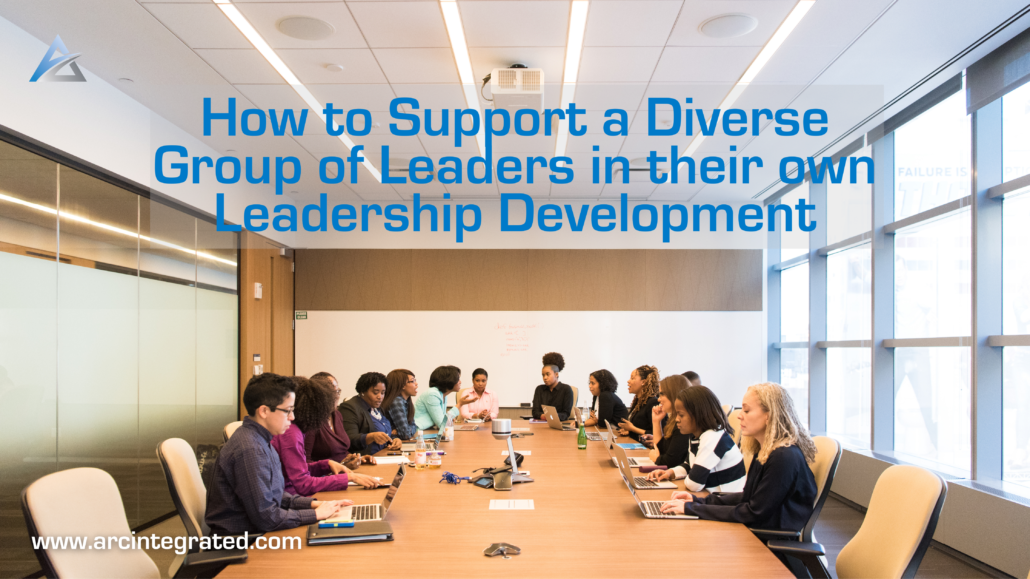How to Support a Diverse Group of Leaders in Their Own Leadership Development

Learning how to support a diverse group of leaders in this day and age is a very important skill to have in your repertoire. In today’s article, I will be outlining five tips for a topic that has emerged as one of the more popular topics that we tackle here at Arc Integrated. The topic is how to support a diverse group of leaders in their own leadership development. So, how exactly do you get a diverse group of leaders and make sure that they get what they need, and that the training is impactful for them so that it creates long term success?
Tip #1: Connect Leaders to One Another
The first tip is to connect the leaders to one another.
You might be asking yourself, why is this valuable? There’s a number of reasons why, but simply put from a learning standpoint, we know that when it comes to learning, the best case outcomes occur when we do experiential learning. Experiential learning is a process where you experience, reflect, think and then ultimately act. When we use this engaging learning process, the longevity and sustainability of the things we learn is exponential as opposed to one way learning. One way learning can take the form of webinars where one person or a group of people are giving out information to an audience that is listening.
The benefit of experiential learning when it comes to diversity is that each person gets to learn:
- Cultural practices
- Empathy
- Cultural perspectives
Tip #2: Challenge Their Biases
In my experience, when you have a group of people in a room that come from different backgrounds and cultures, there are going to be many inherent differences. As a leader, it’s important to challenge our own biases, but it’s equally important to challenge the biases of others as well. This however, is a very tricky line to distinguish when referring to group diversity.
Use Dialogue to Figure Out If It Is a Cultural Bias, or a Cultural Nuance
Is it a cultural bias, or just a cultural nuance? How exactly do you go about figuring out the difference? Dialogue!
It’s critical to remain curious and interested. Keep an open dialogue among the diverse group of leaders so they can learn as much as they can in order to figure out if what they are concerned about is a cultural bias, or a bias that you can comfortably challenge.
Tip #3: Remain Curious & Humble
I believe that constantly remaining curious and humble is a lifelong opportunity that spans far beyond leadership. This is not to say however, that these two specific skills do not have deep rooted benefits for leadership as well – they absolutely do.
In terms of curiosity, it hopefully allows for more learning and works against frustration or anger that comes up during dialog. This is especially important when dealing with a diverse group of people because at some point, you will come across a topic that becomes frustrating. When you are dealing with diversity, people’s perspectives are going to be more nuanced and there will oftentimes be more difference in the room than commonality. By being humble, you hopefully gain perspective that no matter who it is and what their background entails, you can learn something from them.
Tip #4: Know Your Audience
If you are conducting leadership development with a diverse group of people or you have employees where there is a large amount of diversity, it’s important to understand that there are specific perspectives and cultural differences. Therefore, the more you get to know, understand and respect the specific perspectives and cultural differences, the more respect you receive in turn. You can also bring up these conversations with a diverse group of people so everybody can be aware and learn as well.
Call Out Cultural Nuances and Learn From Them
Here at Arc Integrated, we have a lot of experience when it comes to dealing with diverse leaders. When a type of cultural nuance comes up when we are performing leadership or training, we call it out and ask to learn more about it. This gives not only us, but everybody else around us the opportunity to learn because ultimately the more we can understand that we are global citizens the better off we all will be.
Tip #5: Explore Global Issues to Create Connection & Deepen Learning
When thinking about diversity in regards to leadership development, there are certain issues that go past culture or diversity. The technology of VR (virtual reality) is an emerging technical advancement that is being used more and more in the training and development space. The issue with this is the fact that some countries and cultures aren’t going to use VR as readily yet, and depending on where you live, the prevalence of this technology will be more common or less common.
Another example of a global issue that may supersede culture is the idea of VUCA:
- Volatility – how fast things can change in the economy, workplace or world
- Uncertainty – being unsure or unable to predict what is to come
- Complexity – the amount of factors that we need to take note of
- Ambiguity – how clear a situation or problem is
VUCA represents a global problem of different challenges that we all face and the type of responses that follow it. It is important to talk about the nuances of VUCA within both our own culture and our own company.
If you found this article interesting and want to learn more, feel free to watch the video version of 5 Tips to Support a Diverse Group of Leaders. As always, if you want to opt in for my Free Changes Playbook go ahead and give it a go! The Free Changes Playbook will explain how to unlock the 7 pillars to create and manage change as well as help reduce stress as a leader.
Be well,
Michael
Resources:
- Blog Post: How Leadership Skills Can Influence The Values of An Organization
- Blog Post: How to Improve Your Leadership Skills in the Workplace (When We’re All Working Remotely)
- Video: 5 Passive-Aggressive Communication Barriers

